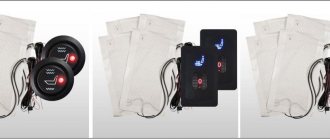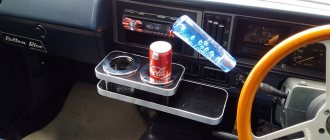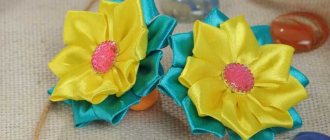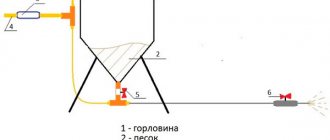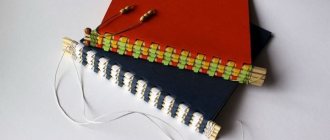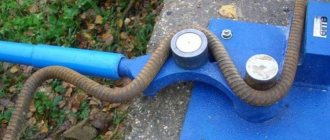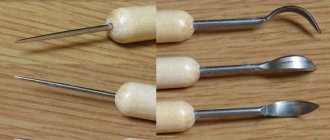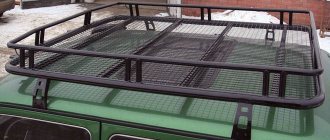Reupholstering car seats is a great way to return the interior to an aesthetically pleasing appearance, because old, worn covers in a car can ruin the entire design. This is especially necessary for a light-colored interior, the upholstery of which has lost its brightness, become stained and cannot be cleaned. Fortunately, now there are many materials and tools that allow you to do the reupholstery yourself. This is not as complicated a procedure as it might seem at first glance; you just need to have basic technical skills and the necessary tools.
Do-it-yourself car seat reupholstery
DIY car seat reupholstery technology
Reupholstering car seats with your own hands is within the capabilities of diligent and persistent people. Since the average car owner does not have the skills to do this kind of work, everything needs to be done slowly, following proven technology.
Preparing to reupholster the seats
Before you start updating your car seats, you first need to do some simple preparatory work:
- Removing seats. Usually fastening is carried out with 4 bolts, but you must first disconnect the negative terminal of the battery in order to de-energize the security system (airbags). Under the seat, you also need to disconnect the electrical wiring terminals, if any, for example, from the electric seat heating.
- Each part of the standard case is signed with a regular marker. You can also indicate the name of the material that will be used in this area of the cover.
- Removing the standard cover from the chair. To carefully remove the old seat trim, you need to press the metal clips on the back of the chair.
- The old cover is cut at the seams into separate parts that will be used as patterns.
- Material calculation. Now each piece of the old cover can be measured and its area can be calculated. The total area of the material must be increased by 20-40%!, which depends on the accuracy of measurements and cutting options.
Making new cases from leather or Alcantara
To make new seat covers you will need some tools and materials:
- gel pen,
- scissors,
- sewing machine,
- foam rubber 5 mm thick,
- glue in a can,
- hammer.
The sequence of actions is as follows.
- Each piece of the old cover is placed on new material and pressed with weights. Use a gel pen to mark with short dashed lines. The marked elements of the new cover are cut out with scissors. When cutting, it is important to take into account such a feature of Alcantara as the direction of the pile. When all elements are combined, the result should be a surface with the same direction of the pile.
- Alcantara and leather are reinforced using fabric-based foam rubber. The connection of the cut parts with the foam rubber is done using glue. You cannot apply the adhesive composition with a brush or roller to the surface of the foam rubber. Therefore, the glue is sprayed evenly from the can.
- The next important step is stitching the patches together. It is important to ensure that the edges of adjacent elements are accurately aligned. This will require some skill in using a sewing machine.
- The seam flaps, spread to the sides, must be glued on the wrong side. First, excess strips of foam rubber and material are cut off, and the lapels are cleaned and degreased. All that remains is to apply glue and press the lapels together.
- An important point in reupholstering the seats will be beating off the seams with a regular hammer.
- The lapels are sewn with a double finishing stitch, and the free edges behind the stitching are not trimmed.
Installing a car seat cover
Installation of a new car seat cover is carried out in the following sequence:
- Before installing the new seat cover, you need to thread the straps. The product is turned inside out and straightened out. The cover is first pulled over the back of the seat.
- Now it’s the “seat’s” turn. Usually this stage does not cause any problems. You need to use plastic clamps threaded through special holes to pull the cover to the base of the chair and secure it by the spoke. The edges of the new cover are stretched evenly along the contour of the seat.
- The leather covering should be completed by heating the material with a stream of hot air. An electric hair dryer is used for this; the main thing is not to overdo it and not burn the case. Gradually drying, the material will stretch like a drum. After this, each chair is steamed using an iron and a damp cloth. Thanks to these thermal operations, the chair cover becomes taut and absolutely smooth.
- The final operation of reupholstering the seats will be to clean the light leather or Alcantara from glue residues, abrasions and fingerprints.
We recommend: Is it possible to flush the cooling system with Coca-Cola or citric acid?
Carefully reupholstered car seats will please the car owner for a long time. During the update process, you can change the design of the car seats, as well as update the upholstery of the doors, ceiling and panels. The comprehensive tuning will change the shabby interior beyond recognition, add elegance to the car and increase its value.
Review of popular brands
The market offers a wide range of products used for reupholstering car interiors. Some of these compounds are very popular.
"Moment"
“Moment” is a universal adhesive composition used for fixing various materials. However, this product is toxic and spreads over the surface. In this regard, “Moment” is usually not used for gluing interior trim.
"Kaiflex K414"
Another polyurethane based product. "Kaiflex K414" stands out from other adhesives in that it provides strong fixation of the finish to the surface and reacts well to temperature changes, maintaining its original properties when the interior overheats.
"Titanium"
“Titanium” is rarely used for upholstery of interior trim. This product takes a long time to dry and does not tolerate temperature changes.
"Demoskol"
"Demoskol" is recommended for reupholstering the interiors of old cars. This composition is characterized by increased moisture resistance. In addition, Demoskol is not affected by temperature changes.
"Glue-88"
A universal product for restoring interior trim. "Glue-88" is used for fixing various materials, including Alcantara and genuine leather. This product is characterized by increased resistance to moisture and temperature changes. The disadvantages of the product include the fact that “Glue-88” does not provide strong fixation of the skin to the surface and emits a distinct unpleasant odor.
"GTA Boterm"
"GTA Boterm" stands out due to its ability to withstand exposure to elevated temperatures and humidity. However, working with this composition is more difficult than with the previous ones. To gain strength, the glue requires temperature exposure (treatment with a construction hair dryer).
Required tools and materials
If you have already decided on the material in which you will reupholster the interior, it’s time to calculate its approximate volume. In total you may need from 6 to 25 meters. But these figures are very approximate: it all depends on the specific car model. So, a crossover or SUV will require much more material than a coupe car. Therefore, do not be lazy and measure the length of the ceiling, the length of the cushions and backrests, the size of the front panel, as well as the width and height of the car doors. Add up all the resulting numbers and add at least a meter as an error. Believe me, you will need it.
In addition to the material itself, you will need other tools:
A set of screwdrivers with straight and Phillips slots for dismantling some elements;
- foam;
- sandpaper;
- degreaser;
- meter tape;
- masking tape;
- cling film;
- marker;
- chalk;
- stationery knife and sharp scissors;
- reinforced threads for stitching leather products;
- sewing machine with a needle and foot for working with leather;
- special high-temperature glue for leather;
- rollers and spatulas with rubber cloth;
- industrial dryer.
Separately, I would like to dwell on the choice of glue. Do not use Moment glue or other similar superglues. Universal glue 88 is often used for reupholstering, but it also has a number of disadvantages. Buy quality glue that can withstand high temperatures. MAH is well suited for these purposes. Its price is quite high, but if you don’t want to see the coating swell and come off after just a few months, spend money on it.
Use high temperature adhesive to bond leather to plastic parts.
Preparing for reupholstery
Working on reupholstery requires perseverance, patience and following recommendations.
Before you start updating the seats, it is necessary to carry out preparatory work:
- dismantle the seats, which are secured with four bolts. Before doing this, disconnect the battery terminal and electrical wiring terminals.
- remove all fragments of old covers and sign them. In addition, it is better to write the name of the material that will be replaced in this place.
- remove the standard cover from the seat, first bend the metal clips from the back. cut the cover at the seams, it will be used to cut a new one.
- calculate the material. Take measurements of each part of the old cover. Make a pattern, leaving at least a few centimeters at the edges.
What functions does the cape perform?
The seat cover decorates the interior of the vehicle. This opinion was widespread several years ago.
However, the interior of the car gets dirty very quickly, stains and scuffs appear, dust and various debris collect. To increase the wear resistance of the factory upholstery, drivers began to use special seat protection.
The car seat cover performs the following functions:
- Protection from mechanical damage and chemical influences.
- Prevents dust and small debris from collecting in hard-to-reach places.
- The factory upholstery is in perfect condition.
- Protection against fading when exposed to UV rays.
- Creating a cozy and comfortable atmosphere in the salon.
- The ability to emphasize the aesthetic appeal and decorativeness of the interior.
- Individual self-expression of the car driver.
Soft backing
A soft lining can be glued to the back of the upholstery. It is especially relevant for the skin. This is a foam material with fabric. The material helps to hold the thread, and it does not fall through the material when sewing. This soft material performs three functions. Firstly, it helps to eliminate wrinkles on the fairly thin upholstery material, and secondly, the soft lining gives better tactile sensations to the surface. Thirdly, this material provides a smooth, even appearance and fullness of the upholstery after installation.
The soft backing is glued with special glue from a can with the soft part to the upholstery, and the fabric outside. The principle of gluing and leveling is the same as when repairing ceiling trim. In addition to gluing, you can additionally stitch along the very edge of the upholstery part. This way the backing is guaranteed not to come off. After this, the excess along the edges of the upholstery part is cut off and the individual upholstery piece can be considered finished.
Let's sum it up
You can always assume that increasing the operating comfort of a car is a good thing. But the costs of this process can be colossal if we are talking about an old domestic car. In this case, you will have to invest a lot of money in the purchase of materials, their preparation, as well as preparatory work in the car itself. Here, even dismantling old seats can be difficult for a master for a number of reasons. When calculating the budget for replacing seats, you should always take into account important factors that indicate the feasibility of such actions and investments. Often, after studying the issue, owners simply abandon such an idea.
Advantages of reupholstering car seats in a studio
We recommend: DIY tips for replacing the Granta liftback fuel filter
If you need to update the seats in a short time and the money issue is not of decisive importance, then it is best to contact a specialized sewing studio.
Among the main advantages of reupholstering seats in a workshop are:
- work performed by qualified specialists with many years of experience,
- use of proven quality materials,
- choosing the preferred option,
- providing a guarantee for the service,
- Minimum turnaround time for reupholstery.
But all these advantages of reupholstering in a workshop can be reduced to zero due to the high cost of the service, which may not be affordable for a simple car enthusiast.
What can be done
If the salon has lost its attractive appearance, you can go one of several ways:
Let it be as it is. Not the best solution, because when worn, the upholstery deteriorates even faster:
- Use T-shirts and covers. They will only hide existing shortcomings. If you expect long-term use or then want to sell the car at a profit, it would be better to restore the interior
- Contact the studio. A good option, but very expensive. In addition to paying for materials, you will also have to pay for the work.
- Pull it yourself. It doesn't save time, but it saves money. You will only have to spend money on consumables.
Which option to choose, everyone decides for himself. Even partially self-performed reupholstery will be much more economical than completely entrusting the work to specialists. They can help you make the covers, and you can do the dismantling, reupholstery and assembly yourself.
Selection of cladding material
Natural and artificial automobile leather are best suited for reupholstering car interiors. Both materials are characterized by high performance qualities, which sets them apart from the less popular carpet or velor. At the same time, leather covering is much easier to do with your own hands than, for example, flocking the interior. The reason for this is the high elasticity of the material, as well as the usual set of necessary tools. Recently, motorists are increasingly choosing Alcantara. However, the price for the original material is almost higher than the cost of genuine leather, while its cheaper substitutes cannot boast of high quality.
For these reasons, we will dwell in more detail on materials such as genuine leather and eco-leather.
Genuine Leather
Genuine automobile leather will become a real decoration of the interior. Is it possible to imagine a luxury car covered with a hard carpet or covered with multi-colored vinyl film?
However, a beautiful appearance is not the only advantage of genuine leather. It can withstand both frost and heat. Cracks will not appear on it due to temperature changes. Another positive property is resistance to ultraviolet radiation. Many materials fade in the sun, so after just a few years of use, the control panel and front seats, which are located directly under the windshield, become noticeably paler compared to the rest of the trim. But this will not affect natural leather. You can be sure that the interior will retain its color.
The interior of the car, covered in leather, looks expensive and solid.
Do not forget about the fire resistance of the material. Accidentally dropped cigarette ash will not harm the interior. Moreover, genuine leather does not absorb foreign odors, which is very important for those who like to smoke inside the car. The skin is also not afraid of other mechanical damage: it will take a lot of effort to scratch or tear such a coating.
On sale you can find material of various textures, including crocodile or ostrich leather. However, when choosing between smooth and perforated leather, it is better to give preference to the latter type. It is softer and more pleasant to the touch. In addition, its wear resistance is noticeably higher.
Perforated leather is softer and more pleasant to the touch
The only thing that can discourage you from upholstering the interior with genuine leather is its price. Its use becomes especially risky when you tighten it yourself. After all, if at some point something goes wrong, a large amount will be thrown away. If you are not ready to take such a risk, turn your attention to eco-leather.
Eco leather
Currently, artificial leather has practically received a second life. Outdated technologies have been replaced by newer ones. Low-quality leatherette is no longer used for upholstery of car interiors, giving way to eco-leather.
Eco leather is a synthetic material. During its manufacture, a thin layer of polyurethane is applied to a woven cotton or polyester base. At the same time, the characteristics of the material directly depend on the thickness of the layer: the thicker it is, the stronger the eco-leather is, but at the same time tougher. For car upholstery, the optimal thickness of polyurethane was experimentally determined.
The material received the name “eco leather” for two reasons. Firstly, during operation it does not emit toxic substances that adversely affect vehicle passengers. And secondly, after its invention, the number of animals killed for their skin decreased sharply, which pleased animal rights activists.
In terms of its external qualities, eco-leather is very close to its natural ancestor. Using special technologies, embossing is applied to the material, making it quite difficult to distinguish it from genuine leather. Moreover, the higher the price of the material, the more identical their appearance.
The appearance of eco-leather is very close to the appearance of natural material
Eco leather has a rich palette. You can use classic black or extreme red in the interior, or you can combine colors to your liking. But coloring natural material will cost you a pretty penny.
In terms of other characteristics, artificial leather is also not inferior to natural leather: wear resistance, moisture resistance and fire resistance are its strong qualities. Both of these materials remain clean for a long time, and if necessary, stains and dust can be easily removed with a wet sponge and soft cloth. It's no secret that many people are allergic to animal fur and skin, as well as the chemicals used in tanning. Eco-leather is perfect for them, as it is absolutely hypoallergenic.
We recommend: Penalty for installing LED lamps in headlights in 2019
At the same time, the cost of eco-leather is several times lower than natural leather, which makes it more accessible to the general public. You can safely take one or two meters in reserve if you are doing self-upholstery for the first time. The remaining material can be used to make a cover for the steering wheel, gear shift lever and other small elements of the car.
Regardless of whether you choose natural or eco-leather, purchase the material from specialized automotive stores. There are many reasons why leather used for making furniture, clothing and shoes is not suitable for upholstery. For example, its instability to temperature changes and reduced wear resistance.
Both natural and artificial materials have drawbacks that may seem insignificant to some. In cold weather, the coating quickly cools down, and in the sun it gets very hot. Accordingly, this slightly reduces the level of comfort. Whether it is worth paying attention to this feature of materials is up to you to decide. In any case, leather is one of the best solutions for interior decoration of a car.
Acura MDX I Solved the problem of a stuck driver's seat!
Due to the sagging of the soft part of the driver's seat and the stretched skin under the butt, I decided to add foam rubber there. I took off the chair and dragged it home, it was so heavy. I grabbed the bottom of the chair from the front and back. I thought I grabbed the frame of the chair from the front, but it turned out to be the guide for adjusting the chair in the horizontal plane. When I came home I discovered that this guide had come out of the grooves. Inside this guide tube there is a cable, the ends of which, when viewed in section, have a square cross-section. One end is inserted into the motor, and the other to the guide rail of the chair. I spent a long time conjuring how to put this guide tube and cable back in, but nothing worked. All upset, I thought why the hell did I take this on. I lost so much time with this tube, I decided to leave it for last.
I started disassembling the seat. I'll tell you no less hemorrhoids there, under the seat there are a bunch of wires and plugs. While I was removing the seat, I also had bad thoughts, because everything that was disassembled needs to be reassembled later in the same way. I removed the seat, started to dismantle the skin, here there are even more hemorrhoids, all the fastenings are on wire rings that are not so easy to loosen. And while you open them with grief, you think about how to attach them back later. Because of the complexity, I think I won’t remove the entire leather cover, I’ll just put foam rubber under the side support. But having overcome my fear, I decide to sort everything out to the end.
As a result, we see the following picture in the photo. The heated seats are intact, there are no burnt wires, the lateral support is very tired. I removed the seat heating, it was glued at the edges, cut out the foam rubber according to the template, glued it to the seat, glued the heating to the new foam rubber and began installing the leather. I did the lateral support last so that this foam would not interfere with attaching the skin in the central part of the seat. It’s not convenient for one person to attach the skin in place, because with the additional foam rubber for fastening the skin, you had to press down very hard, so my wife pushed the foam rubber on one side with her fingers to access the fastening, and I pressed down on the skin with one hand, and hooked the wire rings with the other hand - platypus fastenings. The fingers around the nails hurt on the second day. If someone needs to add foam rubber only for lateral support, then the above-described agony of removing the skin can be avoided. Having removed the seat from the chair, you can move the skin from the side support upward, put foam rubber and pull the skin back. Which is what I did at the end of the whole operation. I placed foam rubber under the side support along the entire length, pulled the skin back and decided that in the place of large folds I needed to add another piece of foam rubber (you can see a piece in the photo).
I attached the seat to the chair frame, attached all the wires and plugs back and set about replacing the removed guide tube. I couldn’t think of anything other than a small collective farm that doesn’t affect the work of the chair. I sawed off half a centimeter from both ends of the tube and made a longitudinal cut on one side of the tube so that the end of the cable could fit into it. I inserted the cable into the tube, inserted the solid end of the tube into the motor, and pushed the motor aside. At the other end of the tube, he bent the cable into the longitudinal slot of the tube, inserted the cable into the right side of the entire structure, and bending the motor with the inserted tube back, the cable on the right fit back into the tube, and the tube wound into the groove on the right side of the structure. Wow, I'm getting smart. As a result, the tube stood in place, I aligned it in the middle and wrapped it with electrical tape at both ends, including the cut on the tube.
For myself, I am once again convinced that no matter where the hand of a simple layman puts his hand, the end result will differ from the stock (manufacturer). In other words, you can always see where Kulibin’s hand has been. I don’t consider myself crooked, because... In life I like to do everything with my own hands, incl. renovation of your apartment with turnkey redevelopment.
Putting on new upholstery and assembling seats
- When all parts of the upholstery are sewn together, it can be put on the seat and back.
- When installing the upholstery, restore all fasteners that were cut off when disassembling the seat. As you assemble, refer to the photographs taken while disassembling the seats.
- The traditional method of fastening upholstery is the use of special rings. As an alternative method for fastening, you can use nylon zip ties of the required size (10 - 20 cm). They must be of good quality and not break.
Start tightening the seat back upholstery by turning it in the opposite direction and gradually unroll it.
- The upholstery on the back of the seat is a little more difficult to install than on the seat itself. It takes some effort to tighten it. The upholstery should be with the back side facing out. It is placed on the upper part of the backrest and unfolds in stages.
- When putting on leather upholstery, it must be treated with hot steam. This is necessary so that the skin “sits” well and tightly into place. Exposure to heat dries out the skin. When heated, the skin weakens and becomes much more pliable. After cooling, it contracts and tightens the seat. If you don't have a steam generator, you can use a hair dryer as an alternative. When using a hair dryer, adjust the temperature so as not to overheat your skin. If there are no adjustments on the hairdryer, then change the heating by changing the distance from the surface. When heating, you don't need to stay in one place for a long time. Faux leather is less sensitive to heat, but also requires caution when heating.
- A safer option would be to steam the inside of the upholstery before putting it on. This way the steam will not damage the front part. After drying, the leather will lie flat on the seat, without folds or wrinkles.
- If the seat has an airbag, the battery must be disconnected when connecting the seat plugs.
Tags: chair
Comments 35
Mesh size 50x50 mm. Workpiece size 1450 X 1000. Material – aluminum 2.5 mm or steel 1 - 1.5 mm. Aluminum seat weight
...I should put it on ZAZ)
Seryoga, the size is more precise...please) I also want one like this, but I don’t have the money)...and your creation suits my pocket and my liking! I'll tell you in advance)
Well, duh! This foam rubber is definitely not an option then!
I don’t quite agree with you here! Then it was necessary to somehow adapt the spring blocks! You will understand when using it!
what spring blocks? this seat should be hard and strong))) in which rally cars have you seen spring-loaded seats? and if you need comfort, there are specially soft versions with developed lateral support
Of course, I respect you for your zeal, but damn, you should have taken an ordinary seat as a basis!
it is much more problematic to redo it than to do it again
I’m building it for myself, and not to participate in competitions) although of course I would like to build such a “car”
Sporty means with developed lateral support and LIGHTWEIGHT. And this is more geared towards sports. It's certainly cool though.
So I’m making it for the buggy; I don’t really need beauty and lightness))
I do drag and for us weight is a scourge. As far as I communicated with buggies, their weight is not in last place.
Yes, we still inhaled taxi fumes))) And as for the rugs and how they will fit the body... you can cover the seat with foam from a balloon, lay a film on top and, as it hardens, sit down a little in the seat so that the anatomy appears)))) And then everything on top is like fabric tarpaulin)) Ps I tell madwolf to cover the whole thing with carpet...cheaply and cheerfully! He says it will wipe off quickly...Well, it depends on how he fidgets)))
do you mean camping mats? is it really an option))
Yes, them. Specifically, Izhevsk - these ones consist of two (winter - 3) layers. Quite wear-resistant, although a little prone to sitting out in heavily loaded areas. Therefore, several layers are needed, then they will dry out and take the shape of the body.
By the way, as an option for budget covering, you can look at tourist rugs produced in Izhevsk. They are made of fairly wear-resistant polyurethane foam, if you put them in 3-4 layers, they should turn out quite comfortable.
It is best to glue such materials to iron using 88 rubber glue, having first lightly shaved the polyurethane foam with sandpaper.
I'm still thinking)) can you advise me? in fact, I was planning to buy “hard” foam rubber and first add it for softness)) you can even use it not with glue, but with a thin wire, as if sewing it on)) then use a leatherette case according to the patterns))) (the leatherette was just left in stock)
Or maybe it would be better to remove the matrix from this chair and make it out of fiberglass or glass mat... then you won’t have the hassle of lightening this chair, which could lead to a decrease in strength... =))) And according to the subject, you can throw in a polyurethane filler and cover it leather deputy =) If, of course, for a buggy, I would also weld a tubular frame for this chair =D)
I’m also thinking of making a tubular frame))) or some kind of support) but there’s no point in removing the matrix; it’s easier, as romanuch wrote: “you can make a model from yellow façade foam by gluing the pieces together with polyurethane foam, sharpen them a little, round the corners, putty, and then You can use this model to make a matrix for a bucket.”
I'm still thinking)) can you advise me? in fact, I was planning to buy “hard” foam rubber and first add it for softness)) you can even use it not with glue, but with a thin wire, as if sewing it on)) then use a leatherette case according to the patterns))) (the leatherette was just left in stock)
If you make a cover, then how to repeat the holes for the seat belts on it, I saw you have them in the drawings (about the glue, I’m looking for it myself, I’ll come across some cool glue, omtmoyachu)
For a buggy, it’s just what you need; right angles emphasize simplicity and aggressiveness. The main thing is to cover it well, by the way, I want to ask what will you use to cover it with and what kind of glue will you use to glue it to the metal?
and by the way, additional holes will be made in it as in the drawing)
Why are you so focused on “normality”? But what happened was abnormal? Made quite clean and neat. If there are no special requirements for the weight of the structure, it’s okay. Add stiffening elements, etch and paint - it will be great.
I would only advise the author to take care of his health in the future and strip off the galvanized steel before welding - the vapors of burnt-out zinc are too toxic and infectious.
I know)) thanks for your concern)) I cooked it outside so that I could breathe more or less normally))
special thank you for your support
Creative thinking is super, try using fiberglass and epoxy, if you succeed you will be very pleased. Well, if there is no one to take a normal bucket from, then with such zeal you can make a model from yellow facade foam by gluing the pieces together with polyurethane foam, sharpen it a little, round the corners, putty on it, and then you can make a matrix for the bucket from this model.
Since May 2013, our portal has expanded the thematic sections of the forum for the exchange of experience: subforums Americans, Koreans, Germans, French, Japanese have been added, due to the increase in the fleets of our visitors.
